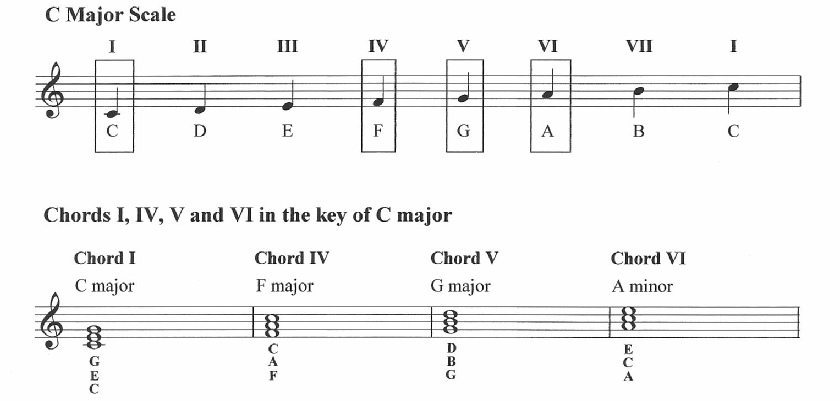






Chord Progression: chords I, IV, V, VI

How to Pass National 5 Music, Concepts at Work Page 4
These chords are built upon the first, fourth, fifth and sixth notes of a scale. For example, in C major:
Identifying chords I, IV, V and VI by ear
To begin training your ear, spend some time playing (or listening to) chords I, IV and V (in any key). Listen to the pitch of each chord in relation to the others. (Start with chords I, IV and V before adding chord VI). Listen to how the pitch ascends or descends between one chord and another, and how chord I can ‘finish’ a phrase as it sounds like an ‘ending.’ Notice how chords IV and V (and, when you come to use it, chord VI) seem to keep the music ‘open’ or ‘unfinished,’ making it obvious that there is more music still to come. Finally, get someone to play these chords for you in no particular order and see if you can identify each one by ear alone. This kind of repetitive practise is a great way to teach your ear so you eventually recognise each chord the way you would an old friend!
You might, for example, come to know each chord for unique characteristics such as:
* Chord I sounds like a ‘final’ chord, the chord on which the music (or a phrase) could end (as in a perfect cadence)
* Chord IV is the second-last chord in a plagal cadence (chord IV - chord I); i.e. the first syllable of the word ‘Amen’ when it is sung at the end of a hymn tune.
* Chord V sounds the highest – or the furthest away – from chord I.
When you feel more confident in your ability to recognise these three chords, try listening to some pieces of music with simple harmony – for example, blues, folk and rock ‘n’ roll styles – as these are likely to be based on (or consist entirely of) chords I, IV and V.
Finally, add Chord VI:
When you are confident in your ability to recognise chords I, IV and V you can include chord VI in the above exercise. Being a minor chord, the sound of chord VI should now be easier to identify by ear in chord progressions using I, IV, V and VI as the other three chords are major chords.







Update RequiredTo play the media you will need to either update your browser to a recent version or update your
Flash plugin.
Audio Example Click ‘play’ to hear the chord examples above
For other music notation examples of these chords in various other keys refer to Keys, Scales and Chords on the Reference Page of this website
For more audio examples of these chords in
various combinations, see Chord Progressions using Chords I, IV, V, VI on the Resources page





















































